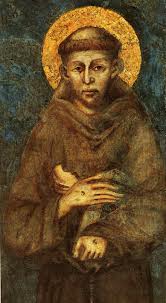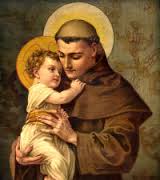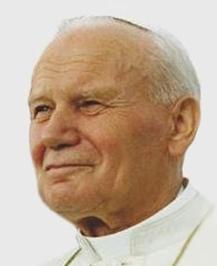Saint Francis of Assisi. Our Holy Father, St. Francis of Assisi – Giovanni Francesco di Bernadone was born in 1182 and died October 3, 1226. He was the son of a wealthy cloth merchant. As a youth, Francesco – or Francis on English – was generous and fun loving, a devotee of Troubadours. His ambition was to become a knight in the service of his beloved city, Assisi. In 1201 in a battle against the neighboring city of Perugia, Francis was wounded and taken prisoner. He returned to Assisi a year later, a physically and spiritually broken young man. Upon recovering, he was a changed person and began to experience a great longing to recognize God’s will in his life. Not long after his return to Assisi, while praying before and ancient crucifix in the forsaken wayside chapel of the Church of San Damiano, he heard a voice saying, Go Francis, and repair my house, which as you see I falling into ruin. In 1209, Francis heard a sermon during Mass in the Chapel of St. Mary of the Angels, in which the Gospel of the day (Matthew 10:9) told how the disciples of Christ were to go forth and proclaim that the Kingdom of Heaven was upon them, that they should take no money, nor even a walking stick or shoes for the road. Francis was inspired to devote himself to a life of poverty, and garbed himself in a coarse woolen tunic, worn by the poorest Umbrian peasants and tied around him with a knotted rope. He went forth to preach penance, brotherly love, and peace, and was soon joined by his first follower, Bernardo di Quintavalle. Within a year, Francis had eleven followers. Francis led his followers to Rome to seek permission to found a new religious order. Pope Innocent II gave his approval and St. Francis called the new order the Friars Minor, that they might always regard the virtue of humility. In order to open the way to God for all who wished to imitate his life, he established s Second Order, the Order of Poor Ladies, later called the Poor Clares, and later a Third Order, intended for men and women who could not leave their homes for a cloistered life. It was, above all, the Passion and Death of Christ on the Cross that filled Francis with love of his Savior. When he was praying on Mount LaVerna, Francis is said to have had a vision on or about September 14, 1224, the Feast of the Exaltation of the Christ. The Crucified Savior appeared to Francis in the form of a Seraph, a six-winged angel on a cross, and impressed upon him the marks of the Five Sacred Wounds, the stigmata. Francis’ attitude towards the natural world, while poetically expressed, was conventionally Christian. He believed that the world was created good and beautiful by God, but is suffers from a need for redemption. He preached to man and beast the universal ability and duty of all creatures to praise God (a common theme in the Psalms) and the duty of men to protect and enjoy nature as both stewards of God’s creation and as creatures ourselves. St. Francis died October 3, 1226, lying on the bare ground in imitation of his Savior’s death on the Cross. St. Francis is known as the patron Saint of animals, the environment and of the two patrons of Italy (with St. Catherine of Sienna). St. Francis was canonized in Assisi by Pope Gregory on Sunday, July 16, 1228.
GETTING CHUMMY WITH THE SAINTS
Witnesses to the Faith and Role Models for the Faithful
St. Anthony of Padua Saint Anthony was canonized (declared a saint) less than one year after his death. There is perhaps no more loved and admired saint in the Catholic Church than Saint Anthony of Padua, a Doctor of the Church. Though his work was in Italy, he was born in Portugal. He first joined the Augustinian Order and then left it and joined the Franciscan Order in 1221, when he was 26 years old. The reason he became a Franciscan was because of the death of the five Franciscan protomartyrs — St. Bernard, St. Peter, St. Otho, St. Accursius, and St. Adjutus — who shed their blood for the Catholic Faith in the year 1220, in Morocco, in North Africa, and whose headless and mutilated bodies had been brought to St. Anthony’s monastery on their way back for burial. St. Anthony became a Franciscan in the hope of shedding his own blood and becoming a martyr. He lived only ten years after joining the Franciscan Order. So simple and resounding was his teaching of the Catholic Faith, so that the most unlettered and innocent might understand it, that he was made a Doctor of the Church by Pope Pius XII in 1946. Saint Anthony was only 36 years old when he died. He is called the “hammer of the Heretics” His great protection against their lies and deceits in the matter of Christian doctrine was to utter, simply and innocently, the Holy Name of Mary. When St. Anthony of Padua found he was preaching the true Gospel of the Catholic Church to heretics who would not listen to him, he then went out and preached it to the fishes. This was not, as liberals and naturalists are trying to say, for the instruction of the fishes, but rather for the glory of God, the delight of the angels, and the easing of his own heart. St. Anthony wanted to profess the Catholic Faith with his mind and his heart, at every moment. He is typically depicted with a book and the Infant Child Jesus, to whom He miraculously appeared, and is commonly referred to today as the “finder of lost articles.” Upon exhumation, some 336 years after his death, his body was found to be corrupted, yet his tongue was totally incorrupt, so perfect were the teachings that had been formed upon it.
Chaplet of St. Anthony of Padua
“Open wide the doors to Christ,” urged St. John Paul II during the homily at the Mass when he was installed as pope in 1978.
Born in Wadowice, Poland, Karol Jozef Wojtyla had lost his mother, father and older brother before his 21st birthday. Karol’s promising academic career at Krakow’s Jagiellonian University was cut short by the outbreak of World War II. While working in a quarry and a chemical factory, he enrolled in an “underground” seminary in Kraków. Ordained in 1946, he was immediately sent to Rome where he earned a doctorate in theology.
Back in Poland, a short assignment as assistant pastor in a rural parish preceded his very fruitful chaplaincy for university students. Soon he earned a doctorate in philosophy and began teaching that subject at Poland’s University of Lublin.
Communist officials allowed him to be appointed auxiliary bishop of Kraków in 1958, considering him a relatively harmless intellectual. They could not have been more wrong!
He attended all four sessions of Vatican II and contributed especially to its Pastoral Constitution on the Church in the Modern World. Appointed as archbishop of Kraków in 1964, he was named a cardinal three years later.
Elected pope in October 1978, he took the name of his short-lived, immediate predecessor. St. Pope John Paul II was the first non-Italian pope in 455 years. In time, he made pastoral visits to 124 countries, including several with small Christian populations.
He promoted ecumenical and interfaith initiatives, especially the 1986 Day of Prayer for World Peace in Assisi. He visited Rome’s Main Synagogue and the Western Wall in Jerusalem; he also established diplomatic relations between the Holy See and Israel. He improved Catholic-Muslim relations and in 2001 visited a mosque in Damascus, Syria.
The Great Jubilee of the Year 2000, a key event in St. John Paul’s ministry, was marked by special celebrations in Rome and elsewhere for Catholics and other Christians. Relations with the Orthodox Churches improved considerably during his ministry as pope.
“Christ is the center of the universe and of human history” was the opening line of his 1979 encyclical, Redeemer of the Human Race. In 1995, he described himself to the United Nations General Assembly as “a witness to hope.”
His 1979 visit to Poland encouraged the growth of the Solidarity movement there and the collapse of Communism in Central and Eastern Europe 10 years later. He began World Youth Day and traveled to several countries for those celebrations. He very much wanted to visit China and the Soviet Union but the governments in those countries prevented that.
In his 27 years of papal ministry, St. John Paul II wrote 14 encyclicals and five books, canonized 482 saints and beatified 1,338 people.
In the last years of his life, he suffered from Parkinson’s disease and was forced to cut back on some of his activities.
Pope Benedict XVI beatified St. John Paul II in 2011, and Pope Francis canonized him in 2014.
 Servant of God Demetrius Gallitzin
Servant of God Demetrius Gallitzin
Demetrius Gallitzin was born on December 22, 1770, in the Hague, Netherlands, to Prince Demetrius Gallitzin, Ambassador of Empress Catherine of Russia, and Countess Amalia von Schmettau, daughter of Field Marshall von Schmettau of Prussia. He left his claim to nobility and came to America in 1792. Wishing to serve God as a priest, he became a seminarian at Saint Mary’s Seminary in Baltimore. On March 18, 1795, Bishop John Carroll ordained Demetrius A. Gallitzin, the first priest to receive all his orders and education for the priesthood in the United States.
He initially came to the Allegheny Mountains on a sick call during the first years of his priesthood. He fell in love with God’s people in the foothills of the Appalachian Mountains. At the persistent request to his Bishop, Father Demetrius Gallitzin was assigned, March 1, 1799, as Pastor to the Catholic settlers in the mountains of Pennsylvania. He hoped to establish a pure Catholic colony in the name of the Church.
For over forty years this evangelizing priest preached the Word of God and celebrated the Sacraments in the name of Jesus Christ. He used all of his personal inheritance to help the people of the Allegheny Mountains. Hundred were baptized and brought into the Church. Thousands received the Eucharist through his priestly ministry. The sick and dying received sacramental grace in their final hours through the love of this pioneer priest.
Servant of God Demetrius A. Gallitzin died on May 6, 1840. As testimony to this man of faith, the Catholic faithful in the Allegheny Mountains continue in their third century to profess a deep-rooted belief in the triune God, the Church, and the intercession of Mary, Mother of God. As Father Demetrius Gallitzin modeled a faithful life of service in proclaiming the truth of Christ and the principles of our faith, we join those who have united their prayers with his in seeking God’s help.
INTERCESSORY PRAYER TO SERVANT OF GOD DEMETRIUS A. GALLITZIN
O God, light of the faithful and shepherd of souls, who sent Servant of God Demetrius Gallitzin to serve God’s people in the Allegheny Mountains feeding your sheep by his words and forming them by his example, pour out your Spirit to sow seeds of truth in people’s hearts and to awaken in them obedience to the faith. May the Gospel continue to be preached and the Sacraments bring power and grace to the faithful. By the example of this man of faith, Demetrius Gallitzin, may your people advance in the path of salvation and love.For more information on Demetrius Gallitzin click here
[audio:http://www.stfrancisofassisijohnstown.com/wp-content/uploads/2013/11/Litanyofthesaints-becker.mp3|titles=Litany of the Saints|autostart=yes]




